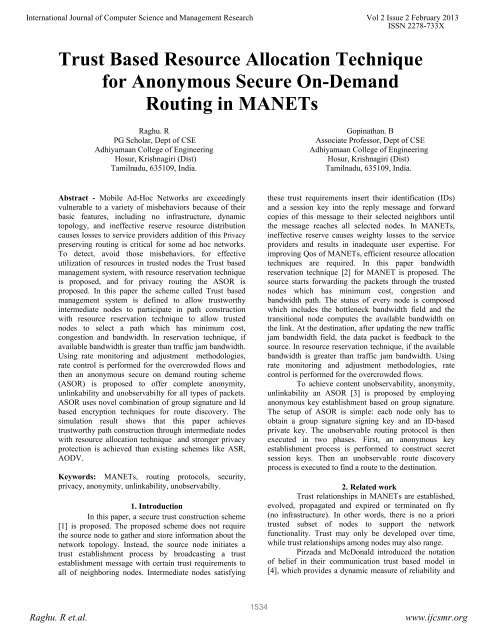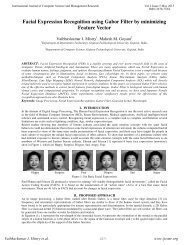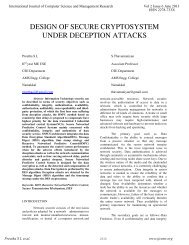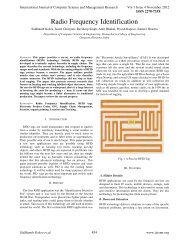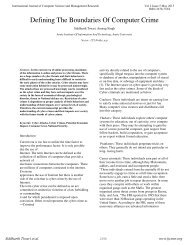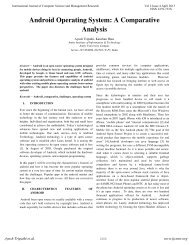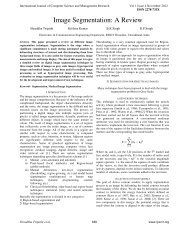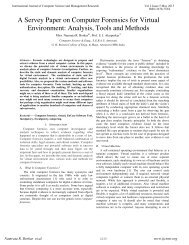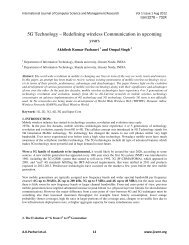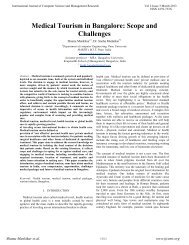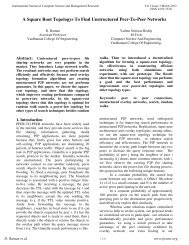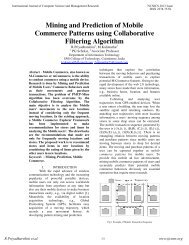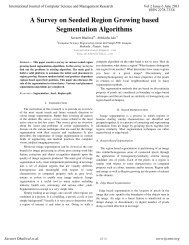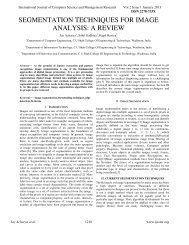Trust Based Resource Allocation Technique for Anonymous ... - ijcsmr
Trust Based Resource Allocation Technique for Anonymous ... - ijcsmr
Trust Based Resource Allocation Technique for Anonymous ... - ijcsmr
Create successful ePaper yourself
Turn your PDF publications into a flip-book with our unique Google optimized e-Paper software.
International Journal of Computer Science and Management Research Vol 2 Issue 2 February 2013<br />
ISSN 2278-733X<br />
<strong>Trust</strong> <strong>Based</strong> <strong>Resource</strong> <strong>Allocation</strong> <strong>Technique</strong><br />
<strong>for</strong> <strong>Anonymous</strong> Secure On-Demand<br />
Routing in MANETs<br />
Raghu. R<br />
Gopinathan. B<br />
PG Scholar, Dept of CSE<br />
Associate Professor, Dept of CSE<br />
Adhiyamaan College of Engineering Adhiyamaan College of Engineering<br />
Hosur, Krishnagiri (Dist)<br />
Hosur, Krishnagiri (Dist)<br />
Tamilnadu, 635109, India. Tamilnadu, 635109, India.<br />
Abstract - Mobile Ad-Hoc Networks are exceedingly<br />
vulnerable to a variety of misbehaviors because of their<br />
basic features, including no infrastructure, dynamic<br />
topology, and ineffective reserve resource distribution<br />
causes losses to service providers addition of this Privacy<br />
preserving routing is critical <strong>for</strong> some ad hoc networks.<br />
To detect, avoid those misbehaviors, <strong>for</strong> effective<br />
utilization of resources in trusted nodes the <strong>Trust</strong> based<br />
management system, with resource reservation technique<br />
is proposed, and <strong>for</strong> privacy routing the ASOR is<br />
proposed. In this paper the scheme called <strong>Trust</strong> based<br />
management system is defined to allow trustworthy<br />
intermediate nodes to participate in path construction<br />
with resource reservation technique to allow trusted<br />
nodes to select a path which has minimum cost,<br />
congestion and bandwidth. In reservation technique, if<br />
available bandwidth is greater than traffic jam bandwidth.<br />
Using rate monitoring and adjustment methodologies,<br />
rate control is per<strong>for</strong>med <strong>for</strong> the overcrowded flows and<br />
then an anonymous secure on demand routing scheme<br />
(ASOR) is proposed to offer complete anonymity,<br />
unlinkability and unobservabilty <strong>for</strong> all types of packets.<br />
ASOR uses novel combination of group signature and Id<br />
based encryption techniques <strong>for</strong> route discovery. The<br />
simulation result shows that this paper achieves<br />
trustworthy path construction through intermediate nodes<br />
with resource allocation technique and stronger privacy<br />
protection is achieved than existing schemes like ASR,<br />
AODV.<br />
Keywords: MANETs, routing protocols, security,<br />
privacy, anonymity, unlinkability, unobservabilty.<br />
1. Introduction<br />
In this paper, a secure trust construction scheme<br />
[1] is proposed. The proposed scheme does not require<br />
the source node to gather and store in<strong>for</strong>mation about the<br />
network topology. Instead, the source node initiates a<br />
trust establishment process by broadcasting a trust<br />
establishment message with certain trust requirements to<br />
all of neighboring nodes. Intermediate nodes satisfying<br />
these trust requirements insert their identification (IDs)<br />
and a session key into the reply message and <strong>for</strong>ward<br />
copies of this message to their selected neighbors until<br />
the message reaches all selected nodes. In MANETs,<br />
ineffective reserve causes weighty losses to the service<br />
providers and results in inadequate user expertise. For<br />
improving Qos of MANETs, efficient resource allocation<br />
techniques are required. In this paper bandwidth<br />
reservation technique [2] <strong>for</strong> MANET is proposed. The<br />
source starts <strong>for</strong>warding the packets through the trusted<br />
nodes which has minimum cost, congestion and<br />
bandwidth path. The status of every node is composed<br />
which includes the bottleneck bandwidth field and the<br />
transitional node computes the available bandwidth on<br />
the link. At the destination, after updating the new traffic<br />
jam bandwidth field, the data packet is feedback to the<br />
source. In resource reservation technique, if the available<br />
bandwidth is greater than traffic jam bandwidth. Using<br />
rate monitoring and adjustment methodologies, rate<br />
control is per<strong>for</strong>med <strong>for</strong> the overcrowded flows.<br />
To achieve content unobservability, anonymity,<br />
unlinkability an ASOR [3] is proposed by employing<br />
anonymous key establishment based on group signature.<br />
The setup of ASOR is simple: each node only has to<br />
obtain a group signature signing key and an ID-based<br />
private key. The unobservable routing protocol is then<br />
executed in two phases. First, an anonymous key<br />
establishment process is per<strong>for</strong>med to construct secret<br />
session keys. Then an unobservable route discovery<br />
process is executed to find a route to the destination.<br />
2. Related work<br />
<strong>Trust</strong> relationships in MANETs are established,<br />
evolved, propagated and expired or terminated on fly<br />
(no infrastructure). In other words, there is no a priori<br />
trusted subset of nodes to support the network<br />
functionality. <strong>Trust</strong> may only be developed over time,<br />
while trust relationships among nodes may also range.<br />
Pirzada and McDonald introduced the notation<br />
of belief in their communication trust based model in<br />
[4], which provides a dynamic measure of reliability and<br />
Raghu. R et.al.<br />
1534<br />
www.<strong>ijcsmr</strong>.org
International Journal of Computer Science and Management Research Vol 2 Issue 2 February 2013<br />
ISSN 2278-733X<br />
trustworthiness suitable <strong>for</strong> applications in an ad-hoc<br />
network. <strong>Trust</strong> model in an adaptation of Marsh’s [5]<br />
trust model, but they merged utility and importance in<br />
one variable called weight <strong>for</strong> simplicity. They<br />
categorized trust into different categories and calculated<br />
trust as a sum of all these weighted categories. <strong>Based</strong> on<br />
the protocol and on the scenario to which the trust model<br />
is applied, the total number of categorized with trust was<br />
defined. The main goal of their model was to build route<br />
trustworthiness in nodes by extending the dynamic<br />
source protocol to receive a complete list of all nodes<br />
through which a protocol has passed.<br />
R.Gunasekaran [6] proposed the high-privileged<br />
and low-privileged architecture (HPLP) <strong>for</strong> Ad Hoc<br />
network <strong>for</strong> achieving optimal differentiated services <strong>for</strong><br />
different classes of users. The new protocol, DMACAW,<br />
was implemented. Among the various factors influencing<br />
the differentiated services, bandwidth reservation is only<br />
considered and different factors that can influence the<br />
efficiency of the bandwidth reservation are identified.<br />
The drawback of this proposed approach is that the<br />
complexity issues such as processing time, transaction<br />
time (latency), buffer management and memory<br />
utilization is not considered.<br />
A number of anonymous routing schemes have<br />
been proposed <strong>for</strong> ad hoc networks in recent years, and<br />
they provide different level of privacy protection at<br />
different cost. Most of them rely on public key<br />
cryptosystems (PKC) to achieve anonymity and<br />
unlinkability in routing.<br />
ASR [7], ARM [8], AnonDSR [9] and ARMR<br />
[10], also make use of one-time public/private key pairs<br />
to achieve anonymity and unlinkability. ASR is designed<br />
to achieve stronger location privacy than ANODR [11],<br />
which ensures nodes on route have no in<strong>for</strong>mation on<br />
their distance to the source/destination node. As the<br />
routing onion used in ANODR exposes distance<br />
in<strong>for</strong>mation to intermediate nodes. ARM considered to<br />
reduce computation burden on one-time public/private<br />
key pair generation. Different from the above schemes,<br />
ARMR uses one-time public keys and bloom filter to<br />
establish multiple routes <strong>for</strong> MANETs. An SDAR and<br />
ODAR [12] use long-term public/private key pairs at<br />
each node <strong>for</strong> anonymous communication. These<br />
schemes are more scalable to network size, but require<br />
more computation ef<strong>for</strong>t. For example, SDAR is similar<br />
to ARM except ARM uses shared secrets between source<br />
and destination <strong>for</strong> verification. Un<strong>for</strong>tunately, ODAR<br />
provides only identity anonymity but not unlinkability <strong>for</strong><br />
MANET, since the entire RREQ/RREP packets are not<br />
protected with session keys. An ALARM [13] makes use<br />
of group signature to preserve privacy. The group<br />
signature has a good privacy preserving feature in that<br />
everyone can verify a group signature but cannot identify<br />
who is the signer. But ALARM still leaks lot sensitive<br />
privacy in<strong>for</strong>mation: network topology, location of every<br />
node.<br />
3. Proposed work<br />
3.1. <strong>Trust</strong> management system<br />
In this approach, the trust level in a node is<br />
defined as a cumulative value that is based on the past<br />
behavior of the node. The trust level of a node increases<br />
as long as the node behaves exactly as it is supposed to<br />
(in our cases, follow reliably the steps of the routing<br />
protocol) or decreases as the node misbehaves<br />
accordingly. A node’s trust is computed by each of its<br />
direct neighboring nodes based on their past experience<br />
or observation of the node’s behavior. These neighboring<br />
nodes, together with the evaluated node, <strong>for</strong>m what we<br />
refer to as a community.<br />
Community and Community Key Management<br />
In our system, a node’s community is as the set<br />
of nodes that includes the node itself, referred as central<br />
node, and all of its one-hop neighboring nodes, among<br />
which some may be malicious. In this approach, a node<br />
keeps track of its neighbors simply by listening <strong>for</strong> a<br />
HELLO message, which is broadcasting periodically by<br />
each node. In each community, the central node classifies<br />
its neighboring nodes into three classes, based on their<br />
trust level. The first and lowest trust level is <strong>for</strong> nodes<br />
whose trust value is between 0 and 1, while the second<br />
trust level, i.e. the medium level, contains the nodes<br />
whose trust level is between 1 and 2. The trust level,<br />
corresponding to the high level, contains the nodes whose<br />
trust value is between 2 and ∞.<br />
The central node generates two different keys<br />
<strong>for</strong> the medium and high trust level, and shares them with<br />
its neighbors. All neighbors in the same trust level share<br />
the same key. The neighbors in high trust level will have<br />
both High <strong>Trust</strong> Level Community Key (HTLCK) and<br />
Medium <strong>Trust</strong> Level Community Key (MTLCK),<br />
whereas, the neighbors in medium trust level have only<br />
MTLCK. As <strong>for</strong> the neighbors in low trust level, they do<br />
not share any community key at all. When the central<br />
node detects a new neighbor, it will assign an initial trust<br />
value to it and updates this trust level later on, based on<br />
their interaction.<br />
<strong>Trust</strong>worthy intermediate node selection mechanism<br />
When a source node initiates the <strong>Trust</strong><br />
establishment process, it specifies the trust level<br />
requirement in the initial message. Each intermediate<br />
node will propagate the message only to selected<br />
neighboring nodes, depending on the source node<br />
requested trust level. If the requested trust level is high,<br />
the node will use the community key <strong>for</strong> the neighbors<br />
with high trust level to encrypt the message; this will<br />
ensure that only highly trusted nodes will participate in<br />
the node selection. If the required trust level is medium,<br />
the node will use the community key <strong>for</strong> the neighbors<br />
Raghu. R et.al.<br />
1535<br />
www.<strong>ijcsmr</strong>.org
International Journal of Computer Science and Management Research Vol 2 Issue 2 February 2013<br />
ISSN 2278-733X<br />
START<br />
Exchange Bacon Messages<br />
to obtain cumulative value<br />
Categorize trusted nodes based on<br />
cumulative Value stored in trust Record<br />
Broadcast <strong>Trust</strong> Req message<br />
Satisfies<br />
<strong>Trust</strong> Req<br />
yes<br />
No<br />
Consider satisfied node as <strong>Trust</strong>ed Node<br />
Broad cast BW Requirement Message<br />
Drop the<br />
packet<br />
with medium or high trust level to encrypt the message.<br />
Using this approach restricts the participation of<br />
intermediate nodes only to the ones that have a certain<br />
trust level.<br />
The source node S triggers the trust<br />
establishment phase by sending a trust establishment<br />
message to all nodes within its range. It consists of<br />
message type (TYPE) trust requirement (TRUST_REQ)<br />
and a one-time public key (TPK). The trust requirement<br />
indicated by TRUST_REQ could be HIGH, MEDIUM or<br />
LOW. TPK is generated <strong>for</strong> each message and used by<br />
each intermediate node to encrypt routing in<strong>for</strong>mation<br />
appended to the message. This key serves also as a<br />
unique identifier <strong>for</strong> the message. The source node<br />
prepares and broadcast the following message to all its<br />
neighbors.<br />
TYPE, TRUST_REQ, TPK (1)<br />
The trust establishment message is <strong>for</strong>warded<br />
from one node to other in the network until it reaches the<br />
all nodes in topology. When the intended intermediate<br />
node gets the trust establishment message it checks the<br />
message was received previously, if yes drop it silently<br />
and stop. If node is intended node it send reply message<br />
to source node to indicate its willingness to become<br />
trusted node and accepts the trust requirement in request<br />
message.<br />
Yes<br />
Bav<br />
>BW BN<br />
No<br />
Drop the<br />
packet<br />
3.2. <strong>Resource</strong> reservation technique<br />
The source starts <strong>for</strong>warding the data packets<br />
through the trusted intermediate nodes which containing<br />
minimum cost, congestion and bandwidth availability<br />
path.<br />
Reserve the Node and Control the Bandwidth by<br />
Using Rate Monitoring Control<br />
<strong>Anonymous</strong> Key Establishment<br />
Route Discovery<br />
Route Req<br />
<strong>Anonymous</strong> Data Transmission<br />
STOP<br />
Route Reply<br />
Figure 1: Overall Diagram of Proposed System<br />
Steps involved in <strong>Resource</strong> reservation<br />
Step1<br />
The source node <strong>for</strong>wards the data packet that<br />
contains the TRUST-REQ, address of source and<br />
destination, flow ID and requested data rate stored in the<br />
BW BN field to the destination. The source node prepares<br />
and broadcast the following message to all its neighbors.<br />
TYPE, TRUST_REQ, TPK, D A , BW BN (2)<br />
Step 2<br />
The intermediate node upon receiving the data packets<br />
determines the B av on its outgoing link.<br />
Step 3<br />
If B av is greater than the BW BN (bottleneck bandwidth)<br />
value, then Node <strong>for</strong>wards the packet to the next node on<br />
the path<br />
Else<br />
Node replaces the BW BN field with the value of B av and<br />
<strong>for</strong>wards the packet to next node.<br />
End if<br />
Raghu. R et.al.<br />
1536<br />
www.<strong>ijcsmr</strong>.org
International Journal of Computer Science and Management Research Vol 2 Issue 2 February 2013<br />
ISSN 2278-733X<br />
This process continues till packet reaches the destination.<br />
Step 4<br />
When the destination node receives the packet, it copies<br />
the value of the BW BN to the new packet and sent back to<br />
the source node using the reverse path.<br />
Step 5<br />
The intermediate node upon receiving the data packet<br />
updates its routing table with the new BW BN and then<br />
<strong>for</strong>warded the packet to the next node.<br />
Step 6<br />
When the data packet reaches the source node, the source<br />
establishes the real-time flow based on the value of the<br />
BW BN field. If the value of B av in source node is greater<br />
than or equal to the BW BN value in the packet. Then<br />
reservation of bandwidth <strong>for</strong> the flow can proceed<br />
Else<br />
The BW BN value in the new data packet is overwritten<br />
with the (smaller) value B av .<br />
end if<br />
Rate monitoring<br />
In the rate monitoring strategy <strong>for</strong> a real time<br />
flow, the rate of flow is measured and compared with the<br />
assigned rate which is updated in the routing table. If the<br />
rate measured is lesser than the reserved rate by the<br />
sufficient margins, then the reserved rate is reduced by<br />
certain factor.<br />
3.3. ASOR: An <strong>Anonymous</strong> routing scheme<br />
The anonymous routing scheme comprises of<br />
two phases: anonymous key establishment as the first<br />
phase and the route discovery process as the second<br />
phase. In the first phase of the scheme, trusted node<br />
employs anonymous key establishment to anonymously<br />
construct a set of session keys with each of its trusted<br />
neighbors. Then under protection of these session keys,<br />
the route discovery process can be initiated by the source<br />
node to discover a route to the destination node.<br />
1. <strong>Anonymous</strong> key establishment<br />
(1) Group signature is computed using its private signing<br />
key, other nodes can verify this signature using the group<br />
public key. Then it broadcasted within its<br />
trusted<br />
neighborhood.<br />
(2) A trusted neighbor X of S receives the message from<br />
S and verifies the signature in that message. If the<br />
verification is successful, X chooses a random number<br />
and computes a signature using its own private key.<br />
(3) Upon receiving the reply from X, , S verifies if it is<br />
valid, S proceeds to compute the session key between X<br />
and itself. S also generates a local broadcast key K S ∗, to<br />
its neighbor X to in<strong>for</strong>m X about the established local<br />
broadcast key. Then X receives the message from S and<br />
computes the same session key. It then decrypts the<br />
message to get the local broadcast key K S ∗.<br />
1. S *: <strong>Trust</strong>_Req, BW BN, r s P, SIGg skS<br />
(r S P)<br />
2. XS: r x P, SIGg skx (r x P), E ksx (K s* )<br />
3. SX:E ksx (K s*<br />
Figure 2. <strong>Anonymous</strong> Key establishment<br />
Figure 2 illustrates the anonymous key establishment<br />
process.<br />
And below table shows notations used in<br />
proposed system.<br />
Table I<br />
Notations<br />
HTLCK<br />
High trust Level Community Key<br />
MTLCK<br />
High trust Level Community Key<br />
TYPE Message Type<br />
TRUST_REQ <strong>Trust</strong> Requirement<br />
TPK<br />
Temporary Public Key<br />
BW BN<br />
Bottleneck Bandwidth<br />
Av<br />
Available Bandwidth<br />
A<br />
A node in Ad hoc N\W, and its identity<br />
S<br />
Secret key owned by server<br />
H i (*) Secure Hash function, I = 1, 2<br />
gsk A<br />
Node A’s private group signature key<br />
gpk<br />
The public group signature key<br />
K A<br />
Node A’s private ID based key<br />
E A (*)<br />
ID based encryption using A’s public<br />
key<br />
K A*<br />
A local broadcast key<br />
K AX<br />
Session key shared b/w A and X<br />
Nym A<br />
Pseudonym only valid within A’s<br />
neighborhood<br />
Nym AX<br />
Pseudonym shared between A and X<br />
2. Route Request (RREQ):<br />
S chooses a random number, and uses the<br />
identity of node D to encrypt a trapdoor in<strong>for</strong>mation that<br />
only can be opened with D’s private IDbased key, S then<br />
selects a sequence number <strong>for</strong> this request, and another<br />
random number as the route pseudonym, which is used as<br />
the index to a specific route entry. To achieve<br />
unobservability, S chooses a nonce and calculates a<br />
pseudonym . After that, S encrypts these items using its<br />
local broadcast key K S∗. . Finally, S broadcast the below<br />
request:<br />
Nonce S , Nym S , E kS∗ (RREQ, N S , E D (S, D, r S P), seqno) (3)<br />
s*)<br />
Raghu. R et.al.<br />
1537<br />
www.<strong>ijcsmr</strong>.org
International Journal of Computer Science and Management Research Vol 2 Issue 2 February 2013<br />
ISSN 2278-733X<br />
Upon receiving the request message from S, A tries all his<br />
session keys shared with all neighbors to calculate<br />
H3(K X∗| Nonce S ) to see which one matches the received<br />
Nym S . Then A would find out k S∗ satisfies Nym S =<br />
H3(K S∗| Nonce S ), so he uses k S∗ to decrypt the ciphertext.<br />
After finding out this is a route request packet, A tries to<br />
decrypt E D using his private IDbased key to see whether<br />
he is the destination node. Suppose, A is not the<br />
destination and his trial fails, so he acts as an<br />
intermediate node. A generates a nonce and a new route<br />
pseudonym <strong>for</strong> this route. He then calculates a<br />
pseudonym. At the end, A prepares and broadcast the<br />
below message:<br />
Nonce A , Nym A , E kA∗(RREQ, N A ,E D (S,D, r S P), seqno) (4)<br />
Other node does same as A does. Finally, the destination<br />
D receives the following message from C<br />
Nonce c , Nym c , E kc∗(RREQ, N c ,E D (S,D, r S P), seqno). (5)<br />
Likewise, D finds out the correct key K C ∗ according to<br />
the equation Nym C = H3(k C ∗|Nonce C ). After decrypting<br />
the ciphertext using k C ∗, D records route pseudonyms and<br />
the sequence number into his route table. Then D<br />
successfully decrypts E D to find out he is the destination<br />
node.<br />
Route Reply (RREP):<br />
The destination D chooses a random number<br />
and computes a cipher text showing that he is the valid<br />
destination capable of opening the trapdoor in<strong>for</strong>mation<br />
he sends the below message to C:<br />
Nonce D , Nym CD ,E kCD (RREP, N C , E S (D, S, r S P, r D P),<br />
seqno). (6)<br />
When C receives the above message from D, he identifies<br />
who the sender of the message is by evaluating the<br />
equation Nym CD = H3(k CD |Nonce D ). So he uses the right<br />
key k CD to decrypts the ciphertext, then he finds out<br />
which route this RREP is related to according to the route<br />
pseudonym N C and seqno. C then searches his route table<br />
and modifies the temporary entry at the end, C chooses a<br />
nonce Nonce C , computes Nym BC = H3(k BC |Nonce C ), and<br />
sends the following message to B:<br />
Nonce c , Nym bc , E kbc (RREP, N b , E S (D, S, r S P, r D P), seqno)<br />
(7)<br />
Other nodes per<strong>for</strong>m the same operations as C does.<br />
Finally, the following route reply is sent back to the<br />
source node S by A<br />
Nonce A , Nym SA, E KSA (RREP, N S , E S (D, S, r S P, r D P),<br />
seqno). (8)<br />
S decrypts the cipher text using the right key kSA and<br />
verifies that E S (D, S, r S P, r D P) is composed faultlessly.<br />
3. Unobservable data transmission<br />
The packets from S must traverse A, B, and C to reach D.<br />
The data packets sent by S take the following <strong>for</strong>mat<br />
Nonce S , Nym SA , E kSA (DATA, N S , seqno, E kSD (payload)).<br />
(9)<br />
Upon receiving the above message from S, A<br />
composes and <strong>for</strong>wards the following packet to B:<br />
Nonce A , Nym AB , E kAB (DATA, N A , seqno, E kSD (payload)).<br />
(10)<br />
The data packet is <strong>for</strong>warded by until it reaches<br />
the destination node D. At the end, the following data<br />
packet is received by D:<br />
Nonce C , Nym CD , E kCD (DATA, N C , seqno, E kSD (payload))<br />
. (11)<br />
5. Conclusion<br />
In this paper, we have proposed an <strong>Trust</strong> based <strong>Resource</strong><br />
reservation technique <strong>for</strong> <strong>Anonymous</strong> secure ondemand<br />
routing in MANETs. <strong>Trust</strong> based management system is<br />
proposed to allow trustworthy intermediate nodes to<br />
participate in path construction with resource reservation<br />
technique to allow trusted nodes to select a path which<br />
has minimum cost, congestion and bandwidth. Then<br />
ASOR is proposed to offer complete anonymity,<br />
unlinkability and unobservabilty <strong>for</strong> all types of packets.<br />
The proposed system offers strong privacy protection,<br />
complete anonymity, unlinkability and content<br />
unobservability <strong>for</strong> ad hoc networks. The proposed<br />
scheme is implemented in ns2 and examined<br />
per<strong>for</strong>mance, which shows that proposed protocol has<br />
satisfactory per<strong>for</strong>mance in terms of packet delivery<br />
ratio, latency and normalized control bytes. Future work<br />
along this direction is to study how to defend against<br />
wormhole attacks, which cannot be prevented with<br />
proposed protocol.<br />
4. Security analysis<br />
A. Proposed system is able to establish a certain trust<br />
requirement if no of Untrusted nodes available in<br />
topology<br />
During the trust establishment process, a source<br />
node broadcasts the trust requirement message to all of<br />
its neighboring nodes, suppose if any node satisfies the<br />
trust requirement in message then the satisfied node will<br />
become trusted intermediate node in topology <strong>for</strong><br />
particular source node. The nodes not satisfying the trust<br />
value in message is not considered <strong>for</strong> communication so<br />
the malicious nodes are prohibited.<br />
B. Effective utilization of available resources<br />
This technique enables the source node to select<br />
a path to destination which has minimum cost,<br />
congestion control, bandwidth and this will be take place<br />
Raghu. R et.al.<br />
1538<br />
www.<strong>ijcsmr</strong>.org
International Journal of Computer Science and Management Research Vol 2 Issue 2 February 2013<br />
ISSN 2278-733X<br />
through trusted intermediate nodes from source to<br />
destination. Suppose if trusted node is not containing<br />
required bandwidth <strong>for</strong> transmission that node will node<br />
considered and will dropped, here the nodes having<br />
required bandwidth will be considered. This technique<br />
avoids transmission of packets to all trusted nodes only<br />
the nodes containing the required bandwidth specified by<br />
source node will take place in transmission process.<br />
C. Anonymity<br />
User anonymity is implemented by group<br />
signature which can be verified without disclosing one’s<br />
identity. Group signature is used to establish session keys<br />
between neighboring nodes, so that they can authenticate<br />
each other anonymously. And subsequent routing<br />
discovery procedure is built on top of these session keys.<br />
Hence it is easy to see that USOR fulfills the anonymity<br />
requirement under both passive and active attacks, as<br />
long as the group signature is secure.<br />
D. Unlinkability<br />
The trapdoor in<strong>for</strong>mation in the route request, is<br />
decrypted and encrypted at each hop. Hence even <strong>for</strong> a<br />
global adversary who can eavesdrop every transmission<br />
within the network, it is impossible <strong>for</strong> him to find<br />
linkage between messages without knowing any<br />
encryption key.<br />
E. Unobservability<br />
A node and its next-hop node or previous-hop<br />
node on route establish a session key anonymously,<br />
hence no one is able to know real identities of its nexthop<br />
node or previous-hop node. Even the source and the<br />
destination node do not know real identities of the<br />
intermediate nodes on route. As a result, USOR offers<br />
content unobservability <strong>for</strong> ad hoc networks.<br />
5. Conclusion<br />
In this paper, we have proposed an <strong>Trust</strong> based<br />
<strong>Resource</strong> reservation technique <strong>for</strong> <strong>Anonymous</strong> secure<br />
ondemand routing in MANETs. <strong>Trust</strong> based management<br />
system is proposed to allow trustworthy intermediate<br />
nodes to participate in path construction with resource<br />
reservation technique to allow trusted nodes to select a<br />
path which has minimum cost, congestion and<br />
bandwidth. Then ASOR is proposed to offer complete<br />
anonymity, unlinkability and unobservabilty <strong>for</strong> all types<br />
of packets. The proposed system offers strong privacy<br />
protection, complete anonymity, unlinkability and<br />
content unobservability <strong>for</strong> ad hoc networks. The<br />
proposed scheme is implemented in ns2 and examined<br />
per<strong>for</strong>mance, which shows that proposed protocol has<br />
satisfactory per<strong>for</strong>mance in terms of packet delivery<br />
ratio, latency and normalized control bytes. Future work<br />
along this direction is to study how to defend against<br />
wormhole attacks, which cannot be prevented with<br />
proposed protocol. And also how to make the<br />
unobservable routing scheme resistant against DoS<br />
attacks is a challenging task that demands in-depth<br />
investigation.<br />
References<br />
[1]. S Azzedine Boukerchea.B, Khalil El-Khatiba, Li Xu<br />
“An efficient secure distributed anonymous routing<br />
protocol <strong>for</strong> mobile and wireless ad hoc networks”, IEEE<br />
Trans.Mobile Comput., vol.1, no.1, Mar. 2002.<br />
[2]. Sarita Singh Bhadauria and Vishnu Kumar Sharma<br />
Department of Elex, MITS, “India Bandwidth<br />
Reservation Routing <strong>Technique</strong> <strong>Based</strong> on Agent in<br />
Mobile Ad Hoc Networks Using Rate Control with<br />
AODV”.<br />
[3]. Zhiguo, Kui Ren, and Ming Gu ” USOR: An<br />
Unobservable Secure On-Demand Routing Protocol <strong>for</strong><br />
MANETs”, IEEE Transactions on wireless<br />
communications, May 2012.<br />
[4]. A.A. Pirzada and C. McDonald, “Establishing <strong>Trust</strong><br />
in pure Adhoc Networks”, in the 27 th Australasiam<br />
Conference on Computer Science, Dunedin, new<br />
Zealand, 2004.<br />
[5]. S. Marsh, ”Formalising <strong>Trust</strong> as a Computational<br />
Concept”, in Department of Computer Science and<br />
mathematics, Vol. Phd:university of Stirling,1994,pp.<br />
184.<br />
[6]. R. Gunasekaran and V. Rhymend Uthariaraj,<br />
“Differentiated Bandwidth <strong>Allocation</strong> in MANET – A<br />
Profile <strong>Based</strong> Approach”, Asian Journal of In<strong>for</strong>mation<br />
Technology, 2007.<br />
[7]. K. E. Defrawy and G. Tsudik,“ALARM: anonymous<br />
location-aided routing in suspicious MANETs”, IEEE<br />
Trans. Mobile Comput., vol. 10, no. 9, pp. 1358, 2011.<br />
[8].S. Seys and B. Preneel, “ARM: anonymous routing<br />
protocol <strong>for</strong> mobile ad hoc networks”, in Proc.<br />
2006 IEEE International Conference on Advanced<br />
In<strong>for</strong>mation Networking and Applications, pp.<br />
133–137.<br />
[9]. J. Kong and X. Hong, “ANODR: anonymous on<br />
demand routing with untraceable routes <strong>for</strong> mobile adhoc<br />
networks”, in Proc. ACM MOBIHOC’ 03.<br />
[10]. Y. Dong, T. W. Chim, V. O. K. Li, S.-M. Yiu, and<br />
C. K. Hui, “ARMR: anonymous routing protocol with<br />
multiple routes <strong>for</strong> communications in mobile ad hoc<br />
networks”, Ad Hoc Networks, vol. 7, no. 8, pp. 1536–<br />
1550, 2009.<br />
[11]. J. Kong and X. Hong, “ANODR: anonymous on<br />
demand routing with untraceable routes <strong>for</strong> mobile adhoc<br />
networks”, in Proc. ACM MOBIHOC’ 03,<br />
[12].D. Sy, R. Chen, and L. Bao, “ODAR: on-demand<br />
anonymous routing in ad hoc networks”, in 2006 IEEE<br />
Conference on Mobile Ad-hoc and Sensor Systems.<br />
[13].K. E. Defrawy and G. Tsudik, “ALARM:<br />
anonymous location-aided routing in suspicious<br />
MANETs”, IEEE Trans. Mobile Comput., vol. 10,no. 9,<br />
pp. 1345–1358, 2011.<br />
Raghu. R et.al.<br />
1539<br />
www.<strong>ijcsmr</strong>.org


